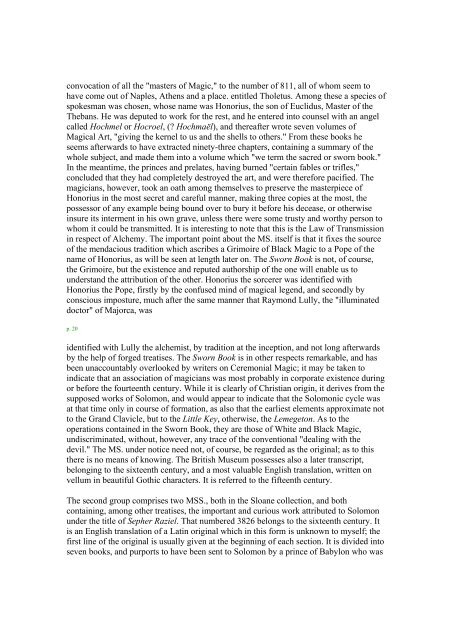the book of ceremonial magic contents - Yankeeclassic.com
the book of ceremonial magic contents - Yankeeclassic.com
the book of ceremonial magic contents - Yankeeclassic.com
Create successful ePaper yourself
Turn your PDF publications into a flip-book with our unique Google optimized e-Paper software.
convocation <strong>of</strong> all <strong>the</strong> "masters <strong>of</strong> Magic," to <strong>the</strong> number <strong>of</strong> 811, all <strong>of</strong> whom seem to<br />
have <strong>com</strong>e out <strong>of</strong> Naples, A<strong>the</strong>ns and a place. entitled Tholetus. Among <strong>the</strong>se a species <strong>of</strong><br />
spokesman was chosen, whose name was Honorius, <strong>the</strong> son <strong>of</strong> Euclidus, Master <strong>of</strong> <strong>the</strong><br />
Thebans. He was deputed to work for <strong>the</strong> rest, and he entered into counsel with an angel<br />
called Hochmel or Hocroel, (? Hochmaël), and <strong>the</strong>reafter wrote seven volumes <strong>of</strong><br />
Magical Art, "giving <strong>the</strong> kernel to us and <strong>the</strong> shells to o<strong>the</strong>rs." From <strong>the</strong>se <strong>book</strong>s he<br />
seems afterwards to have extracted ninety-three chapters, containing a summary <strong>of</strong> <strong>the</strong><br />
whole subject, and made <strong>the</strong>m into a volume which "we term <strong>the</strong> sacred or sworn <strong>book</strong>."<br />
In <strong>the</strong> meantime, <strong>the</strong> princes and prelates, having burned "certain fables or trifles,"<br />
concluded that <strong>the</strong>y had <strong>com</strong>pletely destroyed <strong>the</strong> art, and were <strong>the</strong>refore pacified. The<br />
<strong>magic</strong>ians, however, took an oath among <strong>the</strong>mselves to preserve <strong>the</strong> masterpiece <strong>of</strong><br />
Honorius in <strong>the</strong> most secret and careful manner, making three copies at <strong>the</strong> most, <strong>the</strong><br />
possessor <strong>of</strong> any example being bound over to bury it before his decease, or o<strong>the</strong>rwise<br />
insure its interment in his own grave, unless <strong>the</strong>re were some trusty and worthy person to<br />
whom it could be transmitted. It is interesting to note that this is <strong>the</strong> Law <strong>of</strong> Transmission<br />
in respect <strong>of</strong> Alchemy. The important point about <strong>the</strong> MS. itself is that it fixes <strong>the</strong> source<br />
<strong>of</strong> <strong>the</strong> mendacious tradition which ascribes a Grimoire <strong>of</strong> Black Magic to a Pope <strong>of</strong> <strong>the</strong><br />
name <strong>of</strong> Honorius, as will be seen at length later on. The Sworn Book is not, <strong>of</strong> course,<br />
<strong>the</strong> Grimoire, but <strong>the</strong> existence and reputed authorship <strong>of</strong> <strong>the</strong> one will enable us to<br />
understand <strong>the</strong> attribution <strong>of</strong> <strong>the</strong> o<strong>the</strong>r. Honorius <strong>the</strong> sorcerer was identified with<br />
Honorius <strong>the</strong> Pope, firstly by <strong>the</strong> confused mind <strong>of</strong> <strong>magic</strong>al legend, and secondly by<br />
conscious imposture, much after <strong>the</strong> same manner that Raymond Lully, <strong>the</strong> "illuminated<br />
doctor" <strong>of</strong> Majorca, was<br />
p. 20<br />
identified with Lully <strong>the</strong> alchemist, by tradition at <strong>the</strong> inception, and not long afterwards<br />
by <strong>the</strong> help <strong>of</strong> forged treatises. The Sworn Book is in o<strong>the</strong>r respects remarkable, and has<br />
been unaccountably overlooked by writers on Ceremonial Magic; it may be taken to<br />
indicate that an association <strong>of</strong> <strong>magic</strong>ians was most probably in corporate existence during<br />
or before <strong>the</strong> fourteenth century. While it is clearly <strong>of</strong> Christian origin, it derives from <strong>the</strong><br />
supposed works <strong>of</strong> Solomon, and would appear to indicate that <strong>the</strong> Solomonic cycle was<br />
at that time only in course <strong>of</strong> formation, as also that <strong>the</strong> earliest elements approximate not<br />
to <strong>the</strong> Grand Clavicle, but to <strong>the</strong> Little Key, o<strong>the</strong>rwise, <strong>the</strong> Lemegeton. As to <strong>the</strong><br />
operations contained in <strong>the</strong> Sworn Book, <strong>the</strong>y are those <strong>of</strong> White and Black Magic,<br />
undiscriminated, without, however, any trace <strong>of</strong> <strong>the</strong> conventional "dealing with <strong>the</strong><br />
devil." The MS. under notice need not, <strong>of</strong> course, be regarded as <strong>the</strong> original; as to this<br />
<strong>the</strong>re is no means <strong>of</strong> knowing. The British Museum possesses also a later transcript,<br />
belonging to <strong>the</strong> sixteenth century, and a most valuable English translation, written on<br />
vellum in beautiful Gothic characters. It is referred to <strong>the</strong> fifteenth century.<br />
The second group <strong>com</strong>prises two MSS., both in <strong>the</strong> Sloane collection, and both<br />
containing, among o<strong>the</strong>r treatises, <strong>the</strong> important and curious work attributed to Solomon<br />
under <strong>the</strong> title <strong>of</strong> Sepher Raziel. That numbered 3826 belongs to <strong>the</strong> sixteenth century. It<br />
is an English translation <strong>of</strong> a Latin original which in this form is unknown to myself; <strong>the</strong><br />
first line <strong>of</strong> <strong>the</strong> original is usually given at <strong>the</strong> beginning <strong>of</strong> each section. It is divided into<br />
seven <strong>book</strong>s, and purports to have been sent to Solomon by a prince <strong>of</strong> Babylon who was


